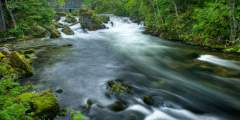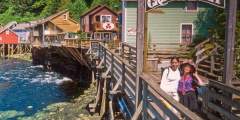Welcome to Ketchikan. Here is a walking tour created by Experience Ketchikan.
Show Map
Walking Tour Points
Visit the visitor information center on the dock for information on visitor related activities and facilities around Ketchikan. Beside the building are a Historic Ketchikan Inc.history kiosk and the ‘rain gauge’.
The first arch was erected in the early 1920s to welcome steamship visitors. An arch using neon lighting was put up by the Chamber of Commerce in the 1950s. This arch was erected by Historic Ketchikan lnc. in 1996.
Built in 1902, St. John’s is the oldest church building standing in Ketchikan. The sanctuary, finished with cedar from a Saxman mill, stood on pilings along the water; fill moved the shore hundreds of feet back. St. John’s has a gift shop. The Yates Building was built as a hospital in 1904 and later housed Alaska Sportsman magazine.
A replica of a pole raised here in 1901 by Tlingit Chief Johnson in honor of the Kadjuk House of the Raven Clan; that pole is now at Totem Heritage Center. Carver Israel Shotridge raised the replica in 1989.
The arts council maintains a gallery and aids Ketchikan’s artists and art-related organizations. Mainstay Gallery’s monthly exhibits feature visual artists, most of them local.
Founded in 1976 as a part-time, 10-watt community station, KRBD is now a 24-hour, Alaska-style mix of volunteers’ music shows and programs from NPR and PRl. Repeaters out of town and on Prince of Wales Island reach most of southern Southeast.The building was a Presbyterian Church, then a contractor’s shop.
In the museum are artifacts,text and photos telling of Alaska’s spirited First City as a Native fish camp, mining hub, salmon canning capital, fishing port and timber town. The Centennial Building commemorates the purchase of Alaska from Russia in 1867. In front is the Raven Stealing the Sun pole, carved by Dempsey Bob and raised in 1983.
This landmark shows how Ketchikan conquers terrain with ingenuity and lumber.
Built in 1912, the warehouse is one of Ketchikan’s oldest remaining commercial structures.The view platform has a great vantage on the creek and salmon schooling for a run up the falls.
See salmon struggle back to their native streambed fighting lower falls.
In the town that boasts of being the Alaskan salmon capital of the world, here’s where you can see the salmon in action — hundreds of thousands come through every summer. This spot, right next the library and at the end of Creek Street, offers a prime view of the crowds of salmon on their way to spawn.
An excellent overlook for salmon in season.
Small ponds in the park go back to the early 1900s, when they were holding ponds for salmon in the city’s first hatchery.The lighted fountain, originally built in the 1930s, was restored to former glory by volunteers in 1989.
Listed on the National Register of Historic Places, this collection of 19th century totem poles is the biggest in the world. Salvaged from abandoned Haida and Tlingit villages, some are as old as 160 years — no small feat, since totem poles usually deteriorate in less than a century. You can take a quick, free tour, or check out the current exhibits of contemporary Tlingit art.
This Episcopal church was built by Ketchikan Native Episcopal Community around 1927, when churches in Ketchikan were segregated. It remained a church until 1962 and now serves as the Ketchikan Mortuary.
K.l.C. is a federally recognized tribal government organized in 1939 under terms of the Indian Reorganization Act of 1934. K.l.C. is involved in health, education and culture issues for Tlingit, Haida and Tsimshian people, along with other Alaska Natives. Northwest Coast-style eagle and raven panels outside the building were produced by Tlingit artist Ernie Smeltzer in 1983 with high school students.
Tlingit artist lsrael Shotridge in 2003 raised this replica of a pole that had stood in the early 1900s on Tongass Island, ancestral home of the Tongass Tribe of Tlingit Indians. Another Sun Raven replica, carved in 1939, still stands in Saxman. The carver gave this new pole to the Tongass Tribe and the community. It stands at the technical center for University of Alaska Southeast Ketchikan campus.
This wood plank street fronts the site of an early Ketchikan dock; in the 1890s it was a makeshift log raft. Thomas Street has been home to boat yards, carpenters, machine shops, bars and bordellos. The Stedman-Thomas area was listed on the National Register of Historic Places in 1996.
The Ketchikan Creek mouth was a broad tidal flat that served until the 1920s as a baseball field; local teams and those from Southeast Alaska and Canada lined out a diamond at low tide. In 1 922, a small seaplane taxied onto the silt with pioneer pilot Roy Jones, first to fly from Seattle to Ketchikan non-stop.The Corps of Engineers dredged the creek mouth in the 1930s to create a harbor. Historic businesses and residences still face the… ...more
In season, see thousands of salmon gathering to run up the creek. Anglers fish from the wide sidewalk on the seawadside
Nearly a century ago in 1903, this was the small mining and fishing town’s red-light district but today the boardwalk street, propped up over Ketchikan Creek on wooden pilings, teems with gift shops, museums and well-preserved homes.
Dolly Arthur was Ketchikan’s most famous madam in the heyday of Creek Street. Her house, preserved much as she left it, features antiques caches and garish décor. Tours are provided for a fee.
A good place to observe the uniqueness of Creek Street: the constant, cool stream and flanking historic buildings on long pilings. See the historical kiosk at the head of the bridge
The lone survivor of more than a dozen papers published here since 1900, the Daily News was founded in 1935.
Our steep terrain challenges engineering and nomenclature alike. This street is really a long set of stairs to a great hillside view of lower downtown, the boat harbor and Tongass Narrows.
Ketchikan’s historic business center.The Heckman Building (1912) is one of the oldest concrete structures in Alaska.
Founded by volunteers around 1900 to protect property and lives in a wooden city built on wood pilings. About 20 career personnel and dozens of volunteers staff two stations. The Main Street facility houses a mint 1927 Seagrave pumper nicknamed “Grandma.” K.F.D. sells patches and souvenir apparel.
Ketchikan’s first fraternal organization dates to 1900 and featured many Ketchikan civic leaders. It was all-white until the 1960s. The original lodge building was at the corner of Mission and Main streets.
This turreted Victorian was built in 1904 for H.Z. Burkhardt,a founder of Ketchikan Power Co., predecessor of Ketchikan Spruce Mill. It’s among our last examples of the Queen Anne style popular in the early 20th century. Listed on the National Register of Historic Places in 1982.
This walkway along the steep hill offers a sensational view of Newtown, the waterfront and First Lutheran Church. Your walk takes you past Nob Hill homes of our prosperous pioneers, dating as early as 1901.
Thundering Wings eagle was carved by world-renowned Tlingit master carver Nathan Jackson of Ketchikan. Across Front Street is the Gilmore Hotel, built in 1927 and listed on the National Register of Historic Places.
Our tunnel is said to be the only one in the world that can be driven through, around and over (on upper Front Street). The tunnel, completed in 1954, eased access to Newtown; before it, a nanow plank street on pilings skirted the rock.
This wood pocket park offers benches, tables and a close-up look at fishing boats, commercial boats, pleasure craft and sometimes fresh seafood sales.
Used by commercial fishers, visitors and the local recreational fleet. In the early 1900s, the home for what was believed to be the world’s largest fleet of halibut boats.





